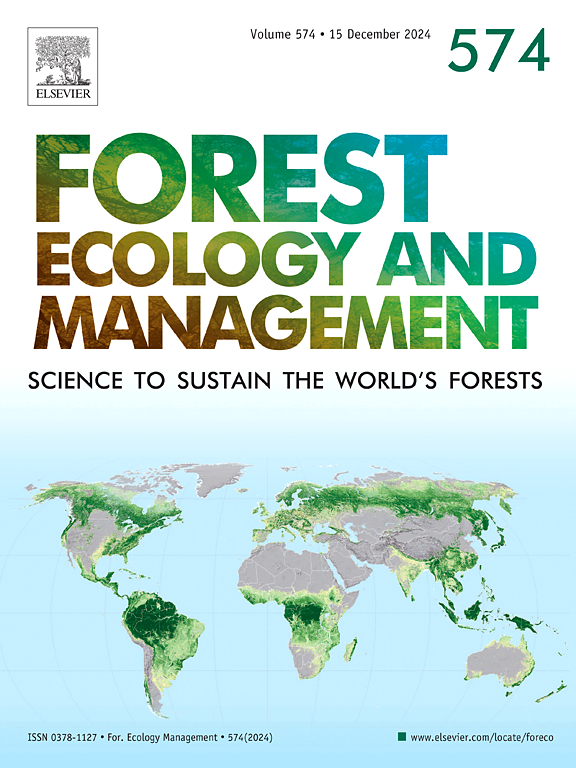Nature vs. nurture: Drivers of site productivity in loblolly pine (Pinus taeda L.) forests in the southeastern US
IF 3.7
2区 农林科学
Q1 FORESTRY
引用次数: 0
Abstract
Forest productivity is one of the most important aspects of forest management, landscape planning, and climate change assessment. However, although there are multiple elements known to affect productivity, most of them rely on the “nature” of the edaphic, climatic, and geographic conditions, and only some specific aspects can be modified through forest management or “nurture”. Through evaluation of site resource availability and an understanding of the main drivers of productivity, management can present solutions to overcome site resource limitations to productivity. Therefore, understanding the implications of a specific management regime requires understanding what drives productivity across large spatial extents and among different management regimes. In this study, we used data from over 1 million hectares of industrial forestland, covering over 6000 different soils and several management regimes of Pinus taeda L. plantations, as well as plot-based data from the Forest Inventory and Analysis (FIA) program, facilitating a comparison of planted and natural Pinus taeda stands. Combined with US Geological Survey LiDAR data, we computed site index and generated wall-to-wall productivity maps for planted Pinus taeda stands in the southeastern US, as well as point-based site index estimates for the FIA dataset. We modeled site index using a random forest algorithm considering edaphic, geologic, and physiographic province information based on the Forest Productivity Cooperative “SPOT” system, and also included climate and management history data. Our model predicted site index with an R2 of 0.701 and RMSE of 1.41 m on the industrial data and R2 of 0.417 and RMSE of 1.84 m for the FIA data. We found that year of establishment of the forest, physiographic province, and geology, were the most important drivers of site index. The soil classification modifier indicating root restrictions were the most important soil-specific variable. Additionally, we found an average increase in site index of 3.05 m since the 1950s for all FIA data, and an average increase of 4.73 m for all industrial data since the 1970s. For the latest period analyzed (2000–2012), average site index in planted FIA plots was 1.2 m higher than naturally regenerated FIA plots, and site index in all industrial forestland had a site index almost 3 m greater than planted FIA plots. Overall, we believe this work sets the foundation for better understanding of forest productivity and highlights the importance of intensive silviculture to improve productivity, and as an additional tool to achieve the economic, environmental, and social objectives.
自然与养育:美国东南部龙柏松(Pinus taeda L.)林地生产力的驱动因素
森林生产力是森林管理、景观规划和气候变化评估的最重要方面之一。然而,尽管已知有多种因素会影响生产力,但其中大部分都依赖于自然环境、气候和地理条件的 "性质",只有某些特定方面可以通过森林管理或 "培育 "来改变。通过评估林地资源可用性和了解生产力的主要驱动因素,管理部门可以提出解决方案,克服林地资源对生产力的限制。因此,要想了解特定管理制度的影响,就必须了解是什么因素在大范围内以及不同管理制度之间推动了生产力的提高。在这项研究中,我们使用了来自 100 多万公顷工业林地的数据,涵盖了 6000 多种不同的土壤和几种种植林的管理制度,以及森林资源清查与分析(FIA)计划中基于地块的数据,以便于对种植林和天然林进行比较。结合美国地质调查局的激光雷达数据,我们计算了地点指数,并生成了美国东南部人工种植的太田针叶林的墙到墙生产力图,以及 FIA 数据集的基于点的地点指数估计值。我们使用随机森林算法对林地指数进行建模,该算法考虑了基于森林生产力合作 "SPOT "系统的土壤、地质和地貌省信息,还包括气候和管理历史数据。我们的模型预测了林地指数,工业数据的 R2 为 0.701,RMSE 为 1.41 米;森林资源评估数据的 R2 为 0.417,RMSE 为 1.84 米。我们发现,建林年份、地理省份和地质是影响地点指数的最重要因素。表明根系限制的土壤分类修饰符是最重要的特定土壤变量。此外,我们还发现,自 20 世纪 50 年代以来,所有森林资源评估数据的林地指数平均增加了 3.05 米,而自 20 世纪 70 年代以来,所有工业数据的林地指数平均增加了 4.73 米。在最近的分析期间(2000-2012 年),人工种植的森林影响评估地块的平均地点指数比自然再生的森林影响评估地块高出 1.2 米,所有工业林地的地点指数比人工种植的森林影响评估地块高出近 3 米。总之,我们认为这项工作为更好地了解森林生产力奠定了基础,并强调了集约造林对提高生产力的重要性,同时也是实现经济、环境和社会目标的又一工具。
本文章由计算机程序翻译,如有差异,请以英文原文为准。
求助全文
约1分钟内获得全文
求助全文
来源期刊

Forest Ecology and Management
农林科学-林学
CiteScore
7.50
自引率
10.80%
发文量
665
审稿时长
39 days
期刊介绍:
Forest Ecology and Management publishes scientific articles linking forest ecology with forest management, focusing on the application of biological, ecological and social knowledge to the management and conservation of plantations and natural forests. The scope of the journal includes all forest ecosystems of the world.
A peer-review process ensures the quality and international interest of the manuscripts accepted for publication. The journal encourages communication between scientists in disparate fields who share a common interest in ecology and forest management, bridging the gap between research workers and forest managers.
We encourage submission of papers that will have the strongest interest and value to the Journal''s international readership. Some key features of papers with strong interest include:
1. Clear connections between the ecology and management of forests;
2. Novel ideas or approaches to important challenges in forest ecology and management;
3. Studies that address a population of interest beyond the scale of single research sites, Three key points in the design of forest experiments, Forest Ecology and Management 255 (2008) 2022-2023);
4. Review Articles on timely, important topics. Authors are welcome to contact one of the editors to discuss the suitability of a potential review manuscript.
The Journal encourages proposals for special issues examining important areas of forest ecology and management. Potential guest editors should contact any of the Editors to begin discussions about topics, potential papers, and other details.
 求助内容:
求助内容: 应助结果提醒方式:
应助结果提醒方式:


